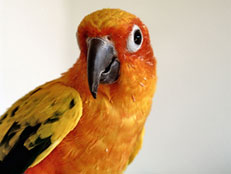
One of the first things you want to teach your new conure is the “Up” command. This lets it step onto your finger, arm or shoulder. This is followed by the “Down” command, as you put it back down.
The initial challenge is to make the conure familiar with your hand. You may not realize this, but the idea of a “moving perch” can be terrifying to birds. You have to convince it that it’s safe. Do this by first gripping one of its existing perches, pulling it against the side of the cage, and slowly moving it towards the conure. It won’t be as frightened since the perch is a familiar object.
Once it gets used to the movement, press the perch against the bird’s legs, forcing it to step on to it to save its balance. Say, at the same time, “Up.” Give a treat and lavish praise. After doing this several times, substitute your hand or arm for the perch.
conure Training-Stopping screaming
Some conures can be very noisy, but don’t lose patience and “scream” right back at it. Remember that it is only trying to communicate something, albeit in a language you can’t understand!
So first rule out if the conure is distressed or upset. Is it hungry? Is it bored? Is it in pain? Is it lonely? Try leaving more toys in the cage, or placing it near a TV or within eye-level of a window.
If you don’t know how to stop the incessant screaming, cover the cage for a few minutes to help it calm down. Only then should you give treats, change the food dish, or take it out of its cage for a few minutes of freedom. Eventually the conure will realize that it gets what it wants when it’s not trying to bring the house down with its screaming. You can also teach it a few words, like “food” or “toy” so it can communicate what it wants, at a decent volume.
conure Training-Potty training and other tricks
Many owners proudly say that they’ve taught their conures dance or acrobatic maneuvers, or even potty training. The trick lies in conditioning: prompt them to do a certain behavior, and then reward them when they complete the task. For example, if you want them to hang upside down from your finger, tilt your hand while you say the command. Give a treat. Eventually the birds will voluntary flip over.
Potty training works the same way. Layer paper in a corner of the cage and wait for them to defecate. When they do, say “Poop!” Praise them. Eventually they will connect the word with the behavior, and not turn the entire cage into a bathroom.